It’s not every day that a relic from a bygone era finds its way to the surface, but when it does, it can provide an invaluable glimpse into the past. Jason Jones, a metal detectorist from Norwich, recently made such a discovery, unearthing a stunning Viking artefact that is soon to be sold at auction.
The bronze object, known as a die, is believed to have been utilized for crafting ornamental patterns to be affixed to a military helmet, as explained by Nigel Mills, a specialist in coins and artefacts at Noonans auctioneers, which is where the object is set for sale.
The die functions as a mould to duplicate the design onto a slim sheet of metal. The metal is pressed into the die, forming the complex pattern. This process is referred to as repoussé. It generates a lightweight decorative element that can be attached to a military helmet.
The find measures 14cm in length, gradually narrowing from 3.2cm to 2.6cm in width, with a weight of 186 grams.
The Viking Era in the United Kingdom: A Chapter of History
The Viking Age, roughly spanning from the late 8th to early 11th century, began when seafaring warriors from the Scandinavian lands – now known as Norway, Denmark, and Sweden – ventured out across the North Sea.
The history of Vikings in the United Kingdom is a rich tapestry of conflict, settlement, and cultural fusion. Their legacy, imprinted in the language, law, and lore of the land, continues to be a subject of fascination and study.

Their initial raids targeted monasteries along the coast, drawn by the wealth these religious establishments held. The infamous raid on the monastery at Lindisfarne in AD 793 is often cited as the beginning of the Viking Age in England.
However, the Vikings were not just raiders and plunderers. As time went on, they started establishing permanent settlements. By the mid-9th century, large areas of what are now England and Scotland were under Viking control. This area, known as the Danelaw, saw a significant influx of Scandinavian settlers who brought their language, laws, and customs with them.
Moreover, the Vikings had a profound influence on the political landscape of the British Isles. They established kingdoms in Ireland and challenged the existing Anglo-Saxon kingdoms in England.
Culturally, the Vikings also left their mark. Elements of the Old Norse language seeped into Old English, influencing its vocabulary and syntax. Even today, many place names in the UK have Viking origins. Additionally, artefacts like the recently discovered Viking die attest to the artistic skills and mythological beliefs of the Vikings.
Yggdrasil and Nidhogg: Iconic Symbols in Viking Mythology
Viking mythology, much like the culture that bore it, is richly complex and deeply intriguing. A key symbol within this mythology is the World Tree, Yggdrasil, and the monstrous serpent, Nidhogg, that resides within its roots.
Yggdrasil, often depicted as an enormous, evergreen ash tree, is said to connect the nine realms of the Norse cosmos. Its branches reach up to the heavens, while its roots delve deep into various underworlds. This majestic tree is a symbol of the interconnectedness of all things, from gods to men to giants, and even to the fearsome beasts that lurk in the shadows.
Entwined within the roots of Yggdrasil is Nidhogg, a monstrous serpent in Viking mythology. This terrifying creature gnaws incessantly at the roots of the World Tree, embodying the forces of destruction and chaos. Despite its destructive nature, Nidhogg plays a crucial role in the Norse cosmological cycle of creation, preservation, and destruction.
The design on the bronze die by the metal detectorist depicts this iconic scene from Viking mythology. It’s an intricate depiction of Yggdrasil with Nidhogg coiling within its roots. This design choice reflects the Vikings’ deep reverence for their mythological tradition and their understanding of the cyclical nature of existence.
The presence of this design on a decorative motif for a military helmet speaks volumes about the importance of these symbols in Viking culture. Warriors going into battle would carry the image of Yggdrasil and Nidhogg, perhaps as a reminder of their place within the grand scheme of the cosmos and the cyclical nature of life and death.
Heading to Auction
This extraordinary find is now set to go under the hammer. The pendant will be auctioned off and is expected to fetch a significant sum due to its historical significance and excellent condition.
The auction house handling the sale has expressed excitement at being able to present such a unique piece to potential buyers. They acknowledge the rarity and the historical value of the pendant, which will undoubtedly attract interest from collectors and historians alike.

